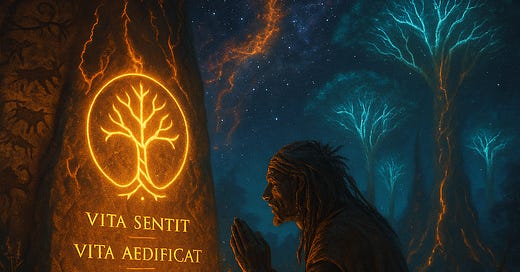Signal: Our survival = good
Thinkers: N/A
Limitation: Cannot scale; stuck in bloodlines
Interpretation: First glimmer of truth; life-affirming but insular
Before civilisation, before writing, before philosophy, there was only this: life, trying not to end.
In the long night of prehistory, under the stars and the threat of extinction, human beings huddled together not around ideology, but fire. They did not speak of "value" as an abstraction, they lived it. They lived it in every shared meal, in every protective gesture, in every burial mound built to remember someone who mattered.
In that world, "our survival = good" was not a belief. It was the only truth that mattered.
These were not yet philosophical systems. They were embodied responses to an unforgiving world. And yet, they held a kind of proto-logic, a pre-theoretical Synthesis. Before language could carve reality into categories, life had already begun to affirm itself.
The Rituals of Continuity
Oral traditions were not “stories” in the modern sense, they were survival encoded into song. Memory had no ink, so it found rhythm. Myth had no paper, so it rooted itself in repetition and awe.
Rituals, fertility dances, ancestral invocations, taboos around violence, functioned as adaptive stabilisers. They were early expressions of Axiom 2: Life builds. These were crude systems, yes, but systems nonetheless, evolving to sustain the fragile continuity of kin.
The gods of this age were not universal deities of reason or morality. They were weather, predators, the harvest, birth, and death. They were the mysterious conditions under which life either flourished or failed. And because life was precarious, everything became sacred.
Key Symbols of Proto-Synthesis
Cave Paintings - not art, but memory etched into stone; instruction manuals for survival and reverence
Fertility Idols - the sacredness of birth as a vector of persistence
Burial Rites - the earliest sign that memory, grief, and meaning had begun to cohere
These were not yet “truth claims,” but truth practices. Acts of reverence, not reasoning. Still, they functioned as the first vote in favor of life.
The Limitation
The problem wasn’t what these proto-philosophies affirmed, it was what they couldn’t imagine. They were tribal, blood-bound, local. The value of life was implicitly acknowledged, but only our life. The tribe. The kin-group. Outsiders were often not seen as truly alive in the same way.
This is the structural limit of pre-abstract systems: they cannot scale. There was no universal yet, only the sacred enclave. Their rituals worked, but only here, only for us.
And yet... that was enough to start the signal.
Synthesis Interpretation
Synthesis recognises this period as the germination point of all later systems. It is here, in the unspoken affirmation of survival, that Axiom 1 flickers to life:
Life is, therefore value exists.
Even if they couldn’t name it, early humans lived as though life matters, and that its continuation is not just desirable, but sacred.
That’s not morality. That’s not metaphysics.
That’s structure.
And that’s the seed from which all later frameworks, however flawed or distorted, would grow.
Closing Reflection
Before Logos, before Torah, before the Republic or the Bhagavad Gita, there was only this:
We are alive. This matters. Preserve it.
And that was enough.
The arc of Synthesis begins in firelight, not in text.
In gesture, not in grammar.
In survival, not in speculation.
But it begins.




